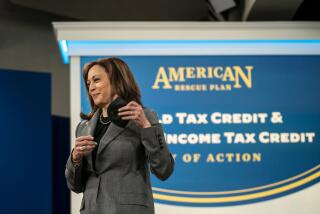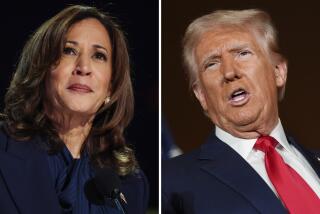Panel Votes to Cut Capital Gains Tax : Narrowly Approved Bill Also Includes 50% Cut in Medicare Surtax on Elderly
WASHINGTON â The House Ways and Means Committee, in a major victory for President Bush and a defeat for the Democratic congressional leadership, narrowly agreed Thursday to a plan that would sharply cut capital gains tax rates through the end of 1991.
Under the proposal, profits on investments from the sale of stock, real estate and most other assets would be taxed at a maximum rate of 19.6%, contrasted with todayâs top rate of 33%. The lower rate would apply to assets held by individuals for at least a year and sold from Sept. 14, 1989, to Dec. 31, 1991.
Starting in 1992, the maximum capital gains rate would rise to 28%. But profits that resulted merely from future inflation would not be taxed.
The Ways and Means Committee included the capital gains cut in a wide-ranging tax bill that would also cut in half the surtax on the elderly that is financing Medicareâs controversial catastrophic care program.
Five Democrats Vote Yes
The committee, meeting behind closed doors, approved the capital gains measure on a 19-17 vote. The proposalâs sponsor, Rep. Ed Jenkins (D-Ga.), was joined by all 13 of the committeeâs Republicans and five generally conservative Democrats who broke with their party leadership.
Committee Chairman Dan Rostenkowski (D-Ill.), after postponing a vote for weeks in hopes of forging a consensus for a more limited capital gains measure, joined 16 other Democrats in opposition to the rate cut.
Bush originally had proposed to cut capital gains taxes to a top rate of 15%, but the Administration swung its support behind the Jenkins plan earlier this summer.
Later Thursday, the committee approved the complete tax bill, which is designed to raise about $6 billion in the fiscal year beginning Oct. 1 and almost $10 billion over a five-year period, by the same 19-17 vote.
The bill is scheduled for action by the full House the week of Sept. 25. Opponents of the capital gains cut acknowledge privately that they will have difficulty defeating the proposal on the House floor, but the measure faces tougher sledding in the Senate, where it is competing with a Democratic plan to expand the tax break for individual retirement accounts.
After capital gains, the billâs changes in the catastrophic care program are its most controversial features. To offset the revenue loss from cutting the surtax, the bill would add another $4 a month to the Medicare premium for insurance to cover doctorsâ fees, which was boosted by $5 on Jan. 1.
The bill would also pare back the prescription drug benefit that is scheduled to take effect next year. And it would allow the elderly to drop out of the catastrophic care program, but only if they also opted out of the doctor fee insurance program, which is so popular that 99% of the elderly now participate.
Opponents of the catastrophic care program are expected to propose that the full House vote to repeal the entire program.
Child Care Tax Credit
The bill approved by the Ways and Means Committee also would expand the tax credit for low-income families to help pay for child care. It includes other new tax breaks as well, including permanent extensions of the research and development tax credit and the credit for building low-income housing.
To pay for these additional tax benefits and raise the necessary additional revenue, the committee agreed to continue indefinitely the 3% telephone tax, to establish a tax on ozone-depleting chemicals, to maintain the 8% airline tax and to boost the ceiling on income subject to Social Security taxes by about $2,000.
They also decided to impose a host of individual taxes aimed at business and investors. These include an end to a tax subsidy for banks engaged in loans to Third World nations and curbs on tax benefits for a limited type of junk bond and certain leveraged buyouts. The bill would also restrict tax-free property swaps and employee stock ownership plans and repeal some special tax breaks for ailing savings and loan institutions.
The committee also decided to repeal a controversial provision of the 1986 tax law that was aimed at preventing companies from providing much more lucrative fringe benefits to their highest-paid employees than to other workers. The committee measure would still prohibit companies from offering benefit packages only to top employees.
The tax bill is part of a broader $14-billion deficit reduction package that includes a variety of spending curbs, including new limits on Medicare payments to doctors.
Senate Democratic leaders, however, are trying to derail the capital gains cut by offering as an alternative a provision to expand tax breaks for IRAs. They hope that their approach will have more political appeal for middle-class voters than the capital gains cut.
If the Jenkins proposal is approved by the House but rejected by the Senate, it could be rejected by the House-Senate conference committee appointed to write the final tax bill. Rostenkowski will control the House delegation to that committee and he probably will make sure that the House delegates oppose the Jenkins plan.
The conference committee also might be tempted to adopt the Houseâs capital gains cut and the Senate Democratsâ IRA plan. That plan, still awaiting Senate action, would provide a partial tax write-off for the IRA contributions of all taxpayers and it would permit early withdrawal of retirement funds for buying a house or paying college expenses.
House leaders promised to turn the vote on capital gains into a partisan battle designed to highlight the differences between Democrats and Republicans. Most Democrats argue that the capital gains tax cut is an unnecessary giveaway to the wealthy that would ultimately drain billions of dollars in revenues from government coffers in future years.
âThis was George Bushâs idea to help his wealthy friends,â said House Majority Leader Richard A. Gephardt (D-Mo.), âand the people who are going to pay for that are the middle class.â
Republicans believe otherwise. Over the short run, the capital gains tax cut is designed to provide a burst of government revenues by encouraging investors to sell their assets and take the profits while the tax rate is low.
Stimulated Investment Seen
Even over the long run, the White House and congressional Republicans contend, the tax cut would boost government revenues by stimulating additional investment and promoting a healthy economy.
âItâs a big win for the country,â argued Rep. Bill Archer (R-Tex.), a co-sponsor of the capital gains tax cut. He predicted victory on the House floor and accused Democrats of trying âto divide class against class.â
Treasury Secretary Nicholas F. Brady described the Ways and Means vote as âa major step forward in providing incentives for long-term investment in the United States. . . .
âWe believe a reduction in the capital gains rate is important for all Americans. It creates jobs. It lowers the cost of capital in the U.S., which is significantly higher than our principal economic competitors, and it promotes economic growth.â
The Jenkins proposal would allow taxpayers to exclude 30% of their capital gains from their taxable income. The remaining 70% would be subject to a maximum tax rate of 28% (the current 33% rate would not apply), for an effective maximum rate of 19.6% for capital gains.
THE CAPITAL GAINS PROPOSAL Key provisions:
--Individuals could exclude 30% of their profits from the sale of investments held more than a year, effective from Sept. 14, 1989, to Dec. 31, 1991.
--The remaining 70% of capital gains would be subject to no more than a 28% tax rate; the 33% rate would not apply.
--Starting in 1992, the 30% exclusion would disappear but the maximum tax rate on capital gains would remain at 28%.
--Starting in 1992, investment profits resulting merely from future inflation would not be taxed.
--The tax benefit would not apply to collectibles such as art, but it would apply to all other investments, including real estate.
Wealthy taxpayers would benefit the most:
Income 1990 tax savings (in millions) $0-10,000 $7 10,000-20,000 $80 20,000-30,000 $201 30,000-40,000 $403 40,000-50,000 $559 50,000-75,000 $1,036 75,000-100,000 $820 100,000-200,000 $3,084 200,000 + $9,373
SOURCE: Joint Committee on Taxation
More to Read
Get the L.A. Times Politics newsletter
Deeply reported insights into legislation, politics and policy from Sacramento, Washington and beyond. In your inbox three times per week.
You may occasionally receive promotional content from the Los Angeles Times.










